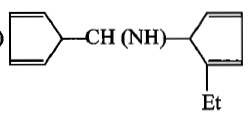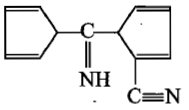Alkyl halide (RX) on treatment with KCN followed by reduction leads to the formation of:
1. RNH2
2. RCH2NH2
3. RH + NH3
4. RCH3 + N2
The end product in the following sequence of reactions is -
1. Ethyl cyanide
2. Ethylamine
3. Methylamine
4. Acetamide
The product[A] formed in the reaction;
1. 
2. 
3. 
4. 
CH3CH2NH2 contains a basic NH2 group, but CH3CONH2 does not, because;
1. acetamide is amphoteric in character
2. in CH3CH2NH2 the electron pair on N-atom is delocalized by resonance
3. in CH3CH2NH2 there is no resonance, while in acetamide the lone pair of electron on N-atom is delocalized and therefore less available for protonation
4. none of the above
Dehydration of an amide gives:
1. Cyanide
2. Amine
3. Isocyanide
4. Fatty acid
Tertiary nitro compounds cannot show tautomerism because:
1. they are very stable
2. isomerises to give sec. nitro compounds
3. do not have labile H-atom
4. they are highly eactive
A secondary amine is:
1. a compound with two -NH2 groups
2. a compound with 2 carbon atoms and a -NH2 group
3. a compound with a -NH2 group on the carbon atom in number 2 position
4. a compound in which 2 of the hydrogens of NH3 have been replaced by alkyl or aryl groups
Compound that will undergo Hoffmann reaction is-
1. RCONHCH3
2. RCOONH4
3. RCONH2
4. RCONHOH
The reagent required to convert acetamide into methyl amine is :
1. NaOH/ Br2
2. Sodalime
3. Hot conc. H2SO4
4. PCl5

The above reaction is an example of....
1. Intermolecular C-N coupling
2. Intramolecular C-N coupling
3. Intermolecular N-N coupling
4. Intramolecular N-N coupling







